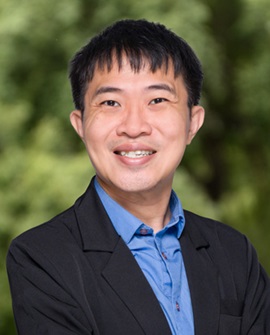Qunxiang ONG

MRI platform lead / Probe development / Optogenetics / Drug discovery
PhD – Organic Chemistry / Chemical Biology, Stanford University, USA
Email: ong_qunxiang@a-star.edu.sg
Lab Page: https://mrmdlab.github.io/
SUMMARY
Qunxiang Ong is a Senior Scientist at the Institute of Molecular and Cell Biology (IMCB), Agency for Science, Technology and Research (A*STAR), leading IMCB MRI platform and at the same time, developing probes to peek into intricacies of biological signalling.
Qunxiang’s research interests lie mainly in the intersection of chemistry and biology, where he seeks to incorporate new tools in tackling challenging and important biological problems. In the capacity as the MRI platform lead, he specialises in hyperpolarized 13C MRS imaging and anatomical imaging in preclinical animal models. In addition, his work also focuses on inventing novel optogenetic tools to modulate protein function with spatiotemporal precision.
Qunxiang is a keen mentor and strong believer in developing future talents for the Singapore scientific scene. In a span of four years, he has mentored over 50 students from polytechnics to universities. He also actively works with industry partners translating novel technologies and bringing them to the market.
Qunxiang obtained his PhD on Organic Chemistry / Chemical Biology from Stanford University in 2018 with his work on optogenetic tools with Prof. Bianxiao Cui, and Bachelor of Arts (B.A.) Natural Sciences (First Class Honours) at the University of Cambridge in 2011.
AWARDS
- 2024: STAR Mentor Award
- 2023: Finalist for Falling Walls Lab Singapore
- 2023: NUS High Inspiring Mentor Award
- 2015: Franklin Veatch Memorial Award – Awarded to top graduate students in Chemistry
- 2012: A*STAR National Science Scholarship (PhD)
- 2006: A*STAR National Science Scholarship (BS)
GRANTS
- 2023: A*STAR Pre-GAP “Magnetic Resonance Imaging (MRI) to precisely predict efficacy of antitumour agents in preclinical models” (Co-I: Ong Qunxiang)
- 2023: A*STAR Pre-GAP “Targeting the BDK-BCKDH system as a therapeutic strategy for HCC” (Co-I: Ong Qunxiang)
- 2023/2024: Singapore Therapeutics Development Review Pre-Pilot Stream 2 and Pilot Award (Co-I: Ong Qunxiang)
- 2021: NMRC Open Fund for Young Individual Research Grant (Lead PI: Ong Qunxiang)
- 2020: NRF Central Gap Fund for COVID-19 projects (Lead PI: Ong Qunxiang)
- 2020: Project “A*CRUSE – UV LED for Disinfection Studies” (Co-I: Ong Qunxiang)
RESEARCH
Magnetic resonance platform – probes and technology development
Magnetic resonance platform – probes and technology development
Our MRI platform is equipped with two ultra-high field MRI scanners at 9.4T and 11.7T respectively, and we are dedicated to develop new techniques for functional and anatomical imaging. Leveraging on our platform, we seek to perform development of small molecules, macromolecules, and nanoparticles capable of sustaining hyperpolarized states for monitoring of their chemical reactions or uptake for extended durations. Hyperpolarized probes are revolutionizing neuroimaging and oncology by offering real-time, non-invasive insights into metabolic alterations that drive diseases. Their ability to enhance MRI sensitivity opens new avenues for early diagnosis, precision medicine, and therapy monitoring, making them powerful tools for both research and clinical applications.
Optogenetic toolkit design for basic science research and translational outcomes
Optogenetic toolkit design for basic science research and translational outcomes
Intracellular optogenetic probes are engineered light-sensitive molecules or proteins that enable precise control of cellular processes using light. These tools have the potential to revolutionize both basic science research and translational medicine, offering unparalleled spatial and temporal control over cellular functions without the need for invasive interventions or pharmacological agents.
In silico to preclinical drug discovery
We collaborate extensively with biocomputational scientists and harness the power of AI to design novel small molecule drugs against anti-cancer targets. We design and perform cellular assays, with the subsequent potential to harness our MRI platform for longitudinal and non-invasive experiments on tumor growth rates.
PUBLICATIONS
- Optogenetic control of Protein Kinase C-epsilon activity reveals its intrinsic signaling properties with spatiotemporal resolution.
Ong, Q.ʈ, Lim C.Y.J., Liao Y., … Han W. ʈ (2025)
bioRxiv (Manuscript in submission; ʈ denotes co-corresponding authors) - Spatiotemporal control of subcellular O-GlcNAc signaling using Opto-OGT.
Ong Q., … Han W. & Yang X. (2025)
Nature Chemical Biology 21, 300–308 - Irradiation of UVC LED at 277 nm inactivates coronaviruses in association to photodegradation of spike protein.
Ong, Q.ʈ, Teo, J. R., Cruz, J. D., Wee, E., Wee, W., & Han, W.ʈ (2022)
Heliyon, 8(10). (ʈ denotes co-corresponding authors) - 222-nanometer far-UVC exposure results in DNA damage and transcriptional changes to mammalian cells.
Ong, Q.ʈ, Wee, W., Dela Cruz, J., Teo, J. W. R., & Han, W. ʈ (2022)
International Journal of Molecular Sciences. 23(16), 9112. (ʈ denotes co-corresponding authors) - O-GlcNAc as an Integrator of Signaling Pathways.
Ong Q, Han W, Yang X. (2018)
Frontiers in Endocrinology. Oct 16; 9:599 - Understanding CRY2 interactions for optical control of intracellular signaling.
Duan L, Hope JM, Ong Q, HY Lou, Kim N, McCarthy C, Acero V, Lin MZ, Cui B. (2017)
Nature Communications. 8, Article number: 547
A*STAR celebrates International Women's Day

From groundbreaking discoveries to cutting-edge research, our researchers are empowering the next generation of female science, technology, engineering and mathematics (STEM) leaders.
Get inspired by our #WomeninSTEM
.png?sfvrsn=c3edc68e_6)